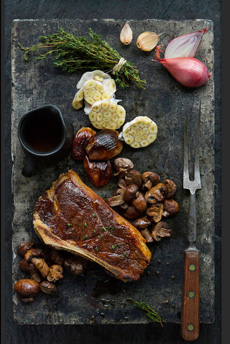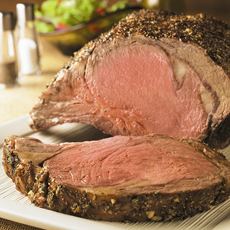TIP OF THE DAY: Beef-Buying Tips (What To Ask The Butcher)
 Lookin’ good: a bone-in strip steak. Photo courtesy Remington’s | Chicago. |
We recently were taken to dinner at Michael Jordan’s The Steak House N.Y.C., located on the lovely balcony of historic Grand Central Terminal in the heart of Manhattan.
We wondered if Executive Chef Cenobio Canalizo would give us some advice on the most important considerations when buying steaks and roasts to cook at home. It’s a big expense, and we want to spend our money wisely. He kindly provided us with these… 1. Is it wet aged or dry aged? Dry-aged beef has a roasted, nutty flavor, while wet-aged beef can taste slightly metallic. Wet-aged beef lacks the depth of flavor of dry-aged, but it can be more tender. Chef Canalizo says most chefs will agree that dry-aged has the preferred flavor; it’s also more expensive. |
|
|
In wet aging, the muscle (beef) rests in a plastic bag in a refrigerated room. With dry-aged, it hangs to age in the air. When you see the word “aged” followed by a given amount of time, and there is no reference to wet or dry, you can safely assume that it is wet-aged beef. Chef Canalizo prefers 21 days of aging. Longer is not always better, he advises. Aging actually causes the meat to decay (a tenderizing process). With too much aging, beef can develop a moldy smell and taste. All beef needs at least 3 weeks to start to tenderize. Naturally raised beef needs more than 6 weeks because the animals are more mature when they are processed. The reason most supermarket beef is tougher is because it is not sufficiently aged. (Aging = time = more expense.) What a steer eats can have a major effect on the nutrient composition of the beef. Grass-fed beef usually contains less total fat than grain-fed beef. Thus, gram for gram, grass-fed beef contains fewer calories. According to AuthorityNutrition.com, while grass-fed beef may contain slightly less total fat than grain-fed beef, equally valuable is that it contains a lot more Omega-3 fatty acids and CLA (conjugated linoleic acid), another fatty acid. Both are very beneficial nutrients. |
||
|
4. How much fat has been trimmed?
Chef Canalizo recommends leaving a quarter inch of fat on top of the steak for flavor. Many people choose cuts with less fat and less marbling. Marbling is the intermingling or dispersion of fat within the lean, and is a prized feature (that’s why Kobe and Wagyu are the most prized beef in the world). The fat adds flavor and helps to tenderize the meat. Also, much of it is “cooked out” before the beef is served. Chef Canalizo recommends 14 ounces (bone included) per guest. You should request cuts that are closest to the bone. The meat is sweeter and there’s more flavor. |
 Our mom’s special occasion go-to dish: a roast beef. She insisted on USDA Prime, and became friendly with a top butcher. Photo courtesy Niman Ranch. |
|
|
6. What’s the grade/quality of the meat? From top down, the grades of beef are USDA Prime, USDA Choice and USDA Select. Additional grades, not available for consumer purchase, are Standard, Commercial, Utility, Cutter and Canner. These latter grades are used in anything from canned chili to pet food. According to the United States Department of Agriculture, a quality grade is a composite evaluation of factors that affect palatability of meat (tenderness, juiciness and flavor). These factors include carcass maturity, firmness, texture and color of the lean, and the amount and distribution of marbling within the lean. Beef is graded in two ways: quality grades for tenderness, juiciness and flavor; and yield grades for the amount of usable lean meat on the carcass. While only the quality grade is important to you as the buyer, you should note that in the yield grade, only 3% of all beef produced in the U.S. is USDA Prime. It’s sold only at top butcher shops and top steak restaurants like Michael Jordan’s. If you’re not going for USDA Prime, be sure you’re getting USDA Choice, not USDA Select.
|
||


